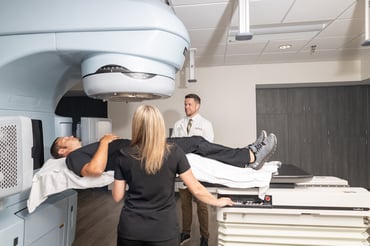
Internal Radiation Therapy vs External Radiation Therapy
There is more than one way to deliver radiation therapy to treat cancer. External beam radiation is most common, using a machine called a linear accelerator that directs beams of radiation to the exact location of the tumor.
Another type of radiation therapy is internal radiation therapy, also called brachytherapy. With internal radiation therapy, radioactive material is placed directly inside the body. This allows the radioactive material to be placed adjacent to the tumor being treated or in the space where surgery was performed to remove a cancerous tumor. This precision prevents nearby tissues and organs from being harmed by radiation.
Brachytherapy is most effective when used with cancers that are localized. It’s not used for cancers that have spread (metastasized) to other areas of the body. It’s most frequently used to treat cancers of the breast, cervix, uterus, vagina, prostate, eye, skin, head, and neck.
Brachytherapy may be your only cancer treatment, or it may be used with other treatments such as external beam radiation therapy, chemotherapy, or surgery.
How Does Brachytherapy Work?
Before treatment begins, you’ll have images made of your tumor using X-rays, an MRI, and/or CT scans. These images make it possible for the radiation oncologist to plan the best treatment for your specific needs and ensure that the radiation is precisely targeted.
There are a few different ways brachytherapy is given to a patient. This is usually dependent on where the cancer is located.
- Intracavitary brachytherapy uses a cylinder or tube that fits the body cavity to place radioactive material inside your body. The images made before treatment started are used to ensure precise placement.
- Interstitial brachytherapy uses a needle or applicator, loaded with radioactive material, to insert radiation directly into tissue or the tumor. Radiation may be delivered via wires, balloons, needles, or tiny rice-grain-size seeds. If a catheter is used, it may be inserted during a surgical procedure and later filled with radiation.
Some interstitial brachytherapy is permanent. This allows the radioactive material to be released continuously. Radiation stays in place for the rest of your life, continually getting weaker until it’s gone.
How Much Radiation is Delivered During Brachytherapy?
Brachytherapy can be administered at a low dose rate (LDR) or high dose rate (HDR). The type you will have depends on your type of cancer, its stage, location, your overall health, age, and your treatment goals.
LDR brachytherapy is usually delivered through a catheter, requiring an inpatient hospital stay. You must stay in bed while the radiation kills the cancer. You’ll have anesthesia before the procedure and won’t feel any discomfort. The catheter or applicator may remain in place during your treatments, or replaced before each treatment. Radiation stays in your body for five to 20 minutes; during once or twice-daily treatment sessions for up to a week. Implants are removed once you’ve received the full dose of radiation.
HDR brachytherapy, sometimes called temporary brachytherapy, is administered as an outpatient over several treatment sessions, or during an in-hospital stay. Radiation is left in the body for five to 20 minutes, then removed. Treatments may be twice a day for five days, or, once a week for up to five weeks. The radioactive material is removed at the end of your session.
With all types of brachytherapy you will emit a low dose of radiation after treatment. While this radiation poses little to no risk to others, ask your oncologist if you should limit time around children or pregnant women. The radioactivity of the implant lessens over time, eventually reaching zero emissions.
After brachytherapy, you’re likely to have additional scans and other follow up imaging to determine if the treatment was successful.
Types of Cancer Treated with HDR and LDR Brachytherapy
- Breast cancer, primarily early-stage breast cancer, can be treated with HDR or LDR brachytherapy, although it’s most often given as HDR brachytherapy after a lumpectomy. The radiation oncologist will place radioactive pellets in applicators aimed at the area where the cancer was located. This is sometimes referred to as five-day breast brachytherapy because the pellets are put into place for a short period of time twice a day, over the course of five days. Using this approach can reduce the total amount of radiation delivered to the breast.
- Prostate cancer is one of the first types of cancer to use permanent brachytherapy. Sometimes called prostate seed treatment, small radioactive “seeds” are inserted into the prostate where they break down on their own over time. LDR brachytherapy is effective for men with low- to medium-grade prostate cancer that has not grown outside of the prostate. It causes few side effects, and most men achieve a full recovery.
HDR brachytherapy for prostate cancer is also an option for some men. Higher dose radioactive seeds are placed into the prostate for short periods of time and then removed. The total treatment time is a few days.
Men at a higher risk of prostate cancer spreading, external beam radiation therapy may be used along with brachytherapy.
- Gynecologic cancers can be treated with either HDR or LDR brachytherapy. How long the implant remains in place depends on your type of cancer. It’s most commonly used for cervical, vaginal or uterine cancer by placing a tube in the vagina where the radiation pellets are placed and left to treat the area. This approach, rather than external beam radiation therapy, causes fewer side effects in the bladder and bowel that can be caused when using external beam radiation therapy in this area of the body.
- Head and neck cancers are treated with brachytherapy alone or in combination with EBRT. An interstitial (most common) or intracavitary implant may be used. It’s inserted in an operating room under general anesthesia. Interstitial implants require six to 10 treatments, usually given over three to five days. Intracavitary implants are inserted, via catheters, into the oral or nasal cavity to reach the tumor. Three to six treatments are required, at least two days apart. The intracavitary method avoids disfigurement, and normal structure and functioning is preserved. The brain, eyes and spinal cord are spared from the radiation.
- Skin cancer is treated with surface HDR brachytherapy. Radiation is placed directly within the tumor. It’s effective for certain types of basal cell or squamous cell skin cancers. Surface HDR has minimal side effects, and is a good alternative for patients who cannot undergo surgery. Other advantages include possibly avoiding the need for reconstructive procedures, more rapid recovery because it causes less injury to normal tissue, and a shorter treatment time, compared to external radiation.
Benefits of Using HDR and LDR Brachytherapy
Both HDR and LDR internal radiation therapy have several important advantages:
- Less damage to surrounding organs and tissue from external beam radiation. This preserves healthy tissue.
- Precise targeting even if the patient and tumor move, internal radiation sources remain precisely targeted.
- Shorter treatment times are easier on the patient and require fewer clinic visits. It also reduces the time that surviving cancer cells can continue to grow.
- No or low side effects because it’s better tolerated and precisely targeted.
- It can be used alone or in combination with other cancer treatments such as surgery, external beam radiation and/or medical oncology (systemic) therapies.
Choosing the Right Radiation Therapy Cancer Center in the Atlanta Area
Radiation oncologists are highly trained in evaluating your specific needs and what treatment will be most effective against your type of cancer. That’s why it is so important to use a radiotherapy center with highly trained and experienced oncologists in all types of radiation therapy, like the team at the Radiotherapy Clinics of Georgia. We have locations throughout the greater Atlanta area including Conyers, Covington, Decatur, and Snellville.



